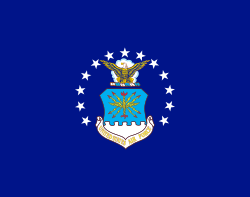 | |
| Other names | Ceremonial Departmental Flag, United States Air Force Departmental Flag, HQ USAF flag |
|---|---|
| Use | Other |
| Proportion | 33:26 |
| Adopted | March 26, 1951 |
| Design | The U.S. Air Force's crest surrounded by thirteen white five-pointed stars on a blue field. |
| Designed by | Dorothy G. Gatchell |
 | |
| Use | Other |
| Proportion | 4:3 |
| Adopted | March 1951 |
| Design | The U.S. Air Force's crest surrounded by thirteen white five-pointed stars on a blue field. |
| Designed by | Dorothy G. Gatchell |
The flag of the United States Air Force was introduced in 1951 and consists of the U.S. Air Force's crest and shield, which itself comprises 13 white stars and the Department of the Air Force's coat of arms on a field of blue. The 13 stars represent the 13 original British American colonies, the three star grouping at the top portray the three Departments of the Department of Defense (Army, Navy, and Air Force). The crest includes the North American bald eagle (the national bird of the US), the cloud formation depicts the creation of a new firmament, and the wreath, composed of six alternate folds of silver and blue, incorporates the colors of the basic shield design.

